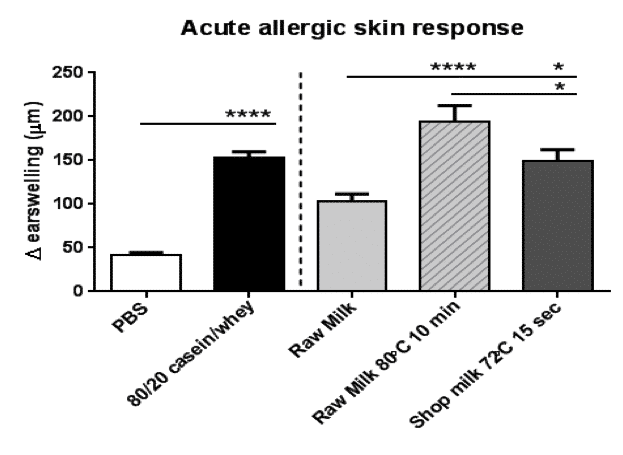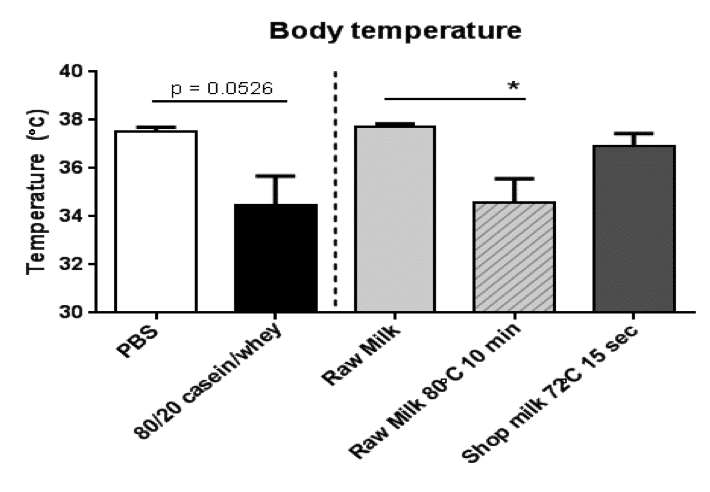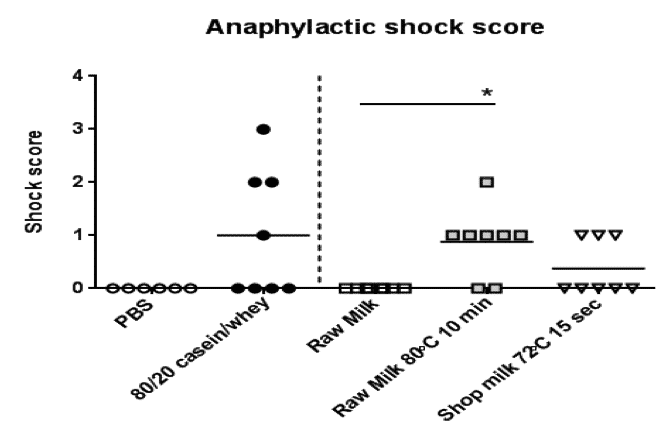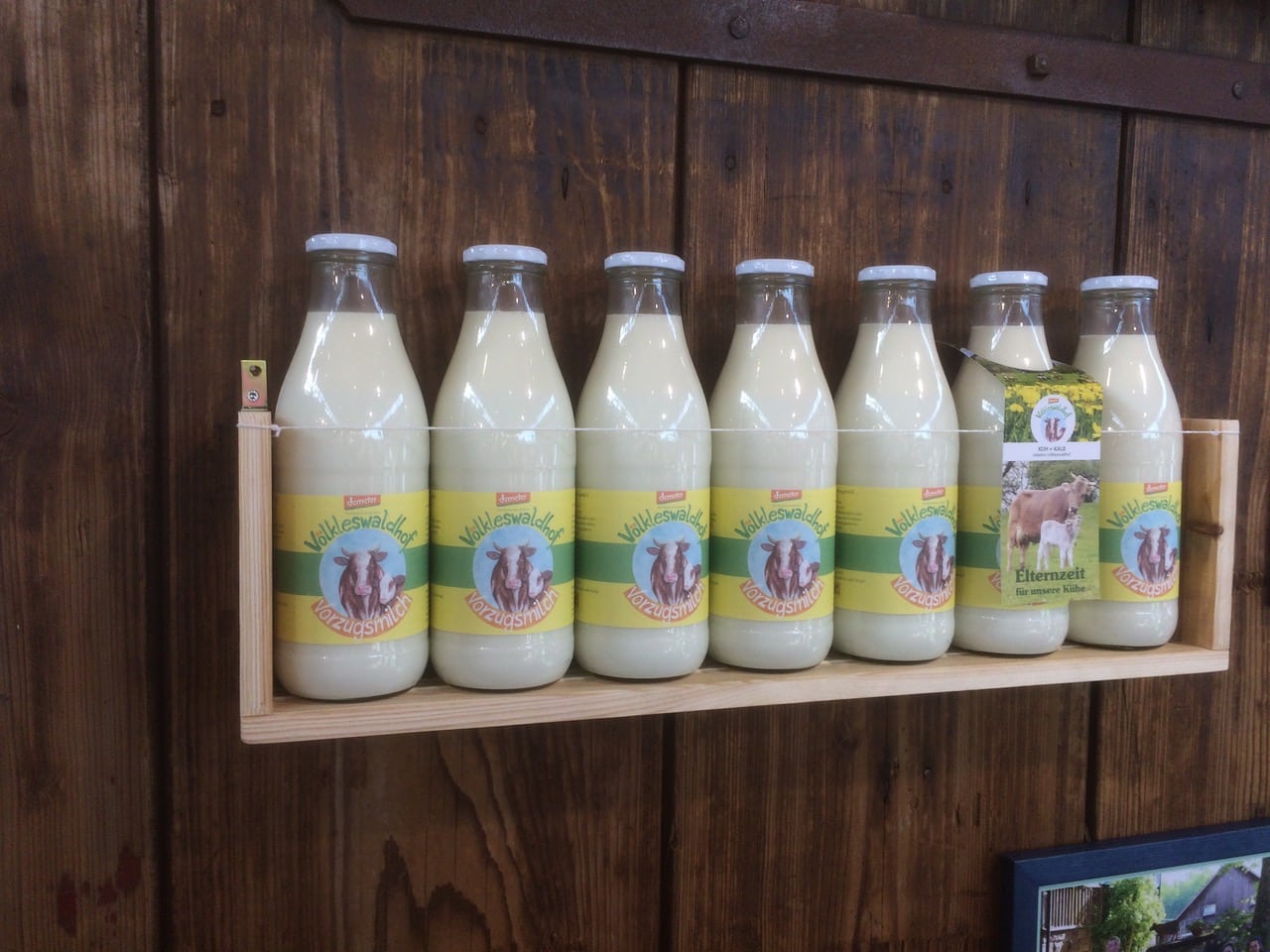Take-home message
- For the first time, a direct relationship has been established between the consumption of heated milk and the development of an allergic reaction, both in young children (1½ years), who were multiple allergic (provocation test) and in a model with allergic mice (tolerance test).
- It is the heating of, in particular, certain whey proteins that are most suspected of causing these problems with milk allergies.
- A recovery also seems possible if allergic children switch to the consumption of raw milk and raw milk products. The latter must be further investigated.
Vorzugsmilch tested in children
In a joint study at Utrecht University (mice) and Kassel University (children), the allergic reactions of different milk types were assessed (Abbring et al., 2019). 18-Month-old children were tested by an allergy MD. They were reported allergic to several foods, including milk. To exclude allergy simulation of a child, the doctor performed a double-blinded provocation test with different milk types. For the provocation test with the young children, “Vorzugsmilch” was chosen as raw cow’s milk. In Germany, Vorzugsmilch is a legal raw milk, which meets the hygiene requirements of the authorities in order to be safe for raw consumption. The legislation of this milk is strictly regulated. For each test, fresh Vorzugsmilch and fresh shop milk were delivered to the doctor. Testing took place at different times of the year with the consent of the parents. The test started with 0.5 ml, then 1 ml, 2.5 ml, with stepwise doubling to 50 ml, until the child showed allergic reactions. To the surprise of the allergy specialist the eleven multiple-allergic children did not show allergic reaction to the raw milk, only to the shop milk. The allergic children could tolerate raw milk up to the maximum 50 ml tested. However, children could show allergies already at 1 ml shop milk and the doctor had to stop at on average 8 ml shop milk due to allergic symptoms.
Mice react just like children
Vorzugsmilch from the same farm was tested in allergic mice, both as raw, unprocessed milk and as heated raw milk (80°C, 10 min) at Utrecht University. This trial also included shop milk. Subsequently, the fresh, sweet whey fraction was separated from the raw farm milk for a second examination. The fresh whey was used both raw and heated (80°C, 6 min).
Young mice are used in food allergy research to better understand allergy in young children. In the 1st trial mice were made sensitive (sensitization phase) for different types of milk, each fed for 5 weeks. Shortly thereafter they were tested with an allergen cow’s milk protein (provocation). In the 2nd trial the sweet whey from the raw milk in trial 1 was taken, both unheated (raw) or heated. Again after 5 weeks, the mice were tested (provocation) with a heated, denatured whey protein. The experimental groups in trial 1 were (A) raw milk, (B) heated raw milk (80°C, 10 min) and (C) pasteurized shop milk. In addition, there were two control groups: mice acting as a negative control never received any milk protein, whereas the positive control mice were treated multiple times with heated cow’s milk protein in order to find with certainty a strong milk allergic reaction. Mice showed up very similar clinical symptoms known in allergic children. There was an anaphylactic shock with a drop of body temperature and skin swelling (wheel size) after injection of the allergenic proteins in the ear. At the end of the study, the mice organs and blood were further examined for various immune parameters. The importance in the mice research is the presence of an animal model for allergy, that expressed similar reactions as in milk allergic children. Earlier, an animal model for asthma was successfully used at Utrecht University (Abbring et al., 2017). In both cases, the same raw milk from a biodynamic certified Vorzugsmilch farm was used.
Raw and heated differed
The mice in trial 1, which grew up on raw milk, did not react allergically to a milk protein allergen during the provocation at week 5, in contrast to mice that grew up on heated raw milk or pasteurized shop milk. Therefore, there is an effect of the heating, rather than the milk origin (biodynamic milk or conventional milk). The difference between the different groups of mice can be interpreted as follows: The raw milk fed mice (A) can be compared with farm children, who grew up on raw milk and did not show any allergic reactions later in their lives (Braun-Fahrländer and Mutius, 2010; Loss et al., 2011). Their immune system develops robustly, but does not react on harmless proteins. For farm children, milk is food and not an allergen. As a result of the consumption of heated milk, mice groups (B) and (C) had developed allergies to milk (Figure 1-3). These mice are comparable to the elven 1½ year old children above, who had visited the doctor as cow’s milk allergic patients. In the case of these children, “something went wrong” in their immunity early in their lives, and they became allergic to cow’s milk, among other foods.

Figure 1. Mice: ear swelling after injecting a milk allergen; PBS = negative control, 80/20 casein = positive control, raw milk = raw Vorzugsmilch, raw milk 80oC = heated Vorzugsmilch, shop milk = pasteurized, homogenized conventional milk; the * indicate significant differences; the more **, the stronger the differences

Figure 2. Mice: changes in body temperature after an allergy reaction; explanation of the groups and significances see figure 1

Figure 3. Mice: anaphylactic shock. Explanation groups see figure 1
The period after the provocation test in children is just as interesting. The doctor who tested the children mentioned that the parents were advised to change the children’s milk diet into raw milk and raw milk products (sour dairy). When he followed up with the children several months later, a large portion of their allergic problems had disappeared, not just the milk allergy. This in itself is special, because it implies a healing process or recovery process after consumption of raw milk (products). The reaction of the children and their recovery afterwards indicates as reversal of an incorrect immune response.
It’s in the whey proteins
In the second mouse trial where only the milk whey was tested, the same results were appeared. After the whey has been heated to 80oC, an allergic reaction developed, whereas no allergies were found in mice that grew up on raw, unheated whey. This is a further indication that the heat-sensitive whey proteins, and in particular the beta-lactoglobulin (BLG), is an important component of the milk allergy problem. BLG is not present in human milk, which means that the intestinal tract and immune system of young children’s immune system must learn that BLG is food and not an allergen. Apparently, this succeeds when the immunity system is trained with raw cow’s milk, but it can fail, if the child is confronted with heated cow’s milk or heated whey at a young age.
If you put these results against research results with purified BLG in a laboratory test, then it is clear that in the range of 50 to 90oC the cow’s milk and the BLG became increasingly allergenic (Karamonova et al., 2010). At higher temperatures, the allergen capacity decreased, because the complex BLG protein completely denatured (“baked milk”).
This article is based on the following publication: Abbring, S., Kusche, D., Roos, T.C., Diks, M.A.P., Hols, G., Garssen, J., Baars, T., & van Esch, B.C.A.M. (2019). Milk processing increases the allergenicity of cow’s milk–preclinical evidence supported by a human proof‐of‐concept provocation pilot. Clinical & Experimental Allergy. First published: 03 April 2019. https://doi.org/10.1111/cea.13399
Photo: Example of German Vorzugsmilch




